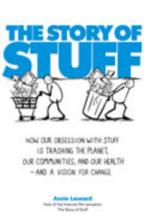To answer these and many more questions, Leonard has published The Story of Stuff: How Our Obsession with Stuff is Trashing the Planet, Our Communities, and Our Health—and a Vision for Change.
In her book, Leonard is as funny yet moving as she is in her short film. She shares personal stories about how she ventured on her quest to find out what happens to our stuff. More of the interconnectedness between people, animals, land, water, and resources is also explored. The film, in fact, is just a starting point; yes, it might inspire you to act—and I hope it did!—but to be truly informed and to answer any questions of people you are educating about the subject, the book really comes in handy.
Leonard goes into detail about many things not talked about in the film. She discusses organic purchases, medical waste, PVC and other hazardous materials, and more. She goes more into detail about corporations, incinerators, and many issues presented in the film. On a hopeful note, she also discusses many positive things that are being done to combat our stuff problem, such as updating mining laws, protecting acres of rainforest, and companies ceasing to export waste or treat it harmfully. Still, there remains much to be done—and while our government, corporations, and very citizens maintain their consumption mentality, there always will be.
One of the most interesting and helpful things I found in Leonard’s book was the story of individual items. She explains, for example, about how 36 gallons of water are needed to make just one cup of coffee—and how 256 gallons are used to create a single t-shirt! No wonder we are experiencing so many water shortages. We tend to not see these hidden costs and resources used to make the stuff we buy; Leonard brings these processes to our attention so we can finally do something about it.
